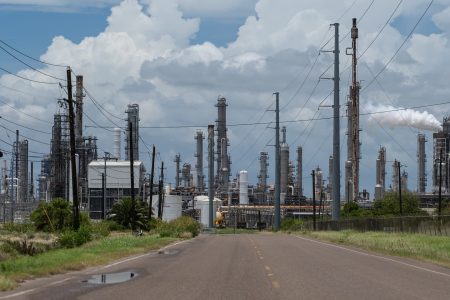
U.S. crude oil futures fell 1% on Monday as traders assessed the impact of Tropical Storm Beryl on Gulf Coast refining, production and export infrastructure.
Beryl made landfall near Matagorda, Texas, as a Category 1 hurricane with maximum sustained winds of 80 miles per hour, according to the National Hurricane Center. Matagorda is about 150 miles northeast of Corpus Christi, a leading crude export facility in the U.S.
Beryl was subsequently downgraded to a tropical storm with maximum sustained winds of 60 miles per hour and is forecast to weaken further, according to the NHC. The storm is moving in a northeast direction.
“Oil and products are sliding on the storm as some of the worst-case scenarios of Hurricane Beryl thankfully, won’t come to be,” Phil Flynn, senior analyst at the Price Futures Group, said in a Monday note.
Here are Monday’s energy prices:
- West Texas Intermediate August contract: $82.33, down 83 cents, or 1%. Year to date, U.S. oil has gained 14.9%.
- Brent September contract: $85.75 per barrel, down 79 cents, or 0.91%. Year to date, the global benchmark is ahead 11.3%.
- RBOB Gasoline August contract: $2.53 per gallon, down 2 cents, or 0.83%. Year to date, gasoline is up 20.7%.
- Natural Gas August contract: $2.36 per thousand cubic feet, up 4 cents, or 2.03%. Year to date, gas is down 5.9%.
Shell shut in production and evacuated personnel from its Perdido platform about 200 miles south of Galveston, according to a company statement Friday. The platform was producing roughly 100,000 barrels per day, or bpd, about 5.5% of oil production in the Gulf of Mexico, according to Andy Lipow, president of Lipow Oil Associates.
“I don’t foresee this storm affecting either supply or price to any significant degree; the consumer will get their gasoline. Most people will not even notice,” Lipow said in a note on Sunday.

WTI vs. Brent
There will be some reduction in refining operations and a delay in getting products to Florida, but the price of gasoline should remain steady through the storm, Lipow said. Afterward, gasoline prices may drift higher as crude futures have risen recently, he said.
Investors are worried about hurricane season this year with Colorado State University forecasting an “extremely active” storm season this year.
Prices at the pump were averaging about $3.50 per gallon nationwide on Monday, about 1 cent higher than last week but 3 cents lower than last month, according to the motorist association AAA.
“There’s enough market momentum to push prices higher throughout the next couple weeks, probably up to about $3.60 or so,” Denton Cinquegrana, chief oil analyst at Oil Price Information Service, told CNBC’s “Fast Money” on Friday.
But gasoline prices are unlikely to hit the $4 per gallon mark unless “we have something really go nuts,” Cinquegrana said.

